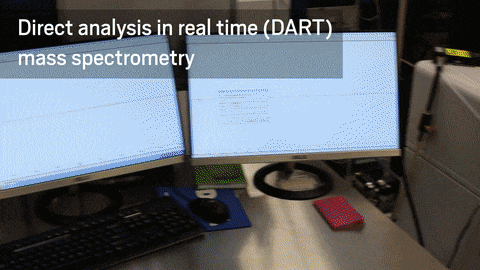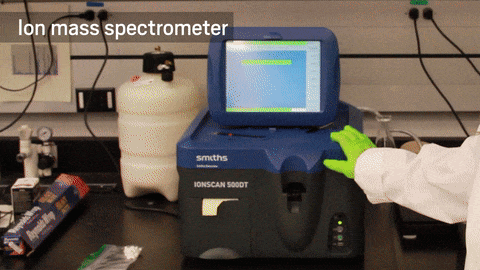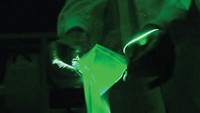Advertisement
Grab your lab coat. Let's get started
Welcome!
Welcome!
Create an account below to get 6 C&EN articles per month, receive newsletters and more - all free.
It seems this is your first time logging in online. Please enter the following information to continue.
As an ACS member you automatically get access to this site. All we need is few more details to create your reading experience.
Not you? Sign in with a different account.
Not you? Sign in with a different account.
ERROR 1
ERROR 1
ERROR 2
ERROR 2
ERROR 2
ERROR 2
ERROR 2
Password and Confirm password must match.
If you have an ACS member number, please enter it here so we can link this account to your membership. (optional)
ERROR 2
ACS values your privacy. By submitting your information, you are gaining access to C&EN and subscribing to our weekly newsletter. We use the information you provide to make your reading experience better, and we will never sell your data to third party members.
Analytical Chemistry
Powerful detection technology for powerful new street drugs
Instruments for identifying opioids aim to protect officers and others from accidental overdose
by Emma Hiolski
November 13, 2017
| A version of this story appeared in
Volume 95, Issue 45
COVER STORY
Powerful detection technology for powerful new street drugs
Lieutenant Detective Patrick Glynn and his fellow officers in the Quincy, Mass., Police Department have been feeling the effects of the opioid crisis for nearly a decade. Because of skyrocketing overdose rates, by October 2010, the department began stocking naloxone, a rapid antidote to overdose, in every police cruiser and made sure every officer was trained to administer it.
Nowadays, the Quincy officers keep naloxone on hand, not just to treat overdose victims at a scene but also to treat officers who are accidentally exposed to increasingly prevalent, highly potent opioids like fentanyl. “First, we were looking to assist the public,” Glynn says, “and now that same medication is ensuring the officers’ safety.”
According to the U.S. Centers for Disease Control & Prevention, law enforcement encountered the synthetic opioid fentanyl twice as often in 2015 as just a year before. Whether it’s a routine traffic stop or a search of an illicit drug lab, officers are more often finding themselves at risk of exposure to dangerous drugs. Narcotics officers have even had suspects fling powder at them in an attempt to escape, Glynn says.
As the opioid epidemic spreads throughout the U.S., the safety of law enforcement officers and lab technicians dealing with drug samples has become a major concern. Fentanyl is extremely potent—50–100 times as potent as morphine and 30–50 times as potent as heroin. A dose as small as 2–3 mg can be fatal.
The synthetic opioid is so dangerous, the U.S. Drug Enforcement Administration has advised law enforcement agencies to send suspected drug samples straight to the lab for testing instead of using routine drug test kits on the scene. But the flood of samples can overwhelm crime labs. To help relieve that burden and prevent accidental exposure to deadly opioids on the streets or in the lab, scientists have developed rapid techniques that can safely identify dangerous compounds without having to open pouches or containers.
A potent danger
Quincy provides one snapshot of the larger drug epidemic plaguing the U.S. Provisional data from CDC indicate that about 64,000 people died of drug overdoses in 2016. In 2015, 63% of overdose deaths—more than 33,000—were attributed to opioids. Opioid overdoses, which have quadrupled since 1999, have in the past four years been driven by the rising prevalence of fentanyl and other synthetic opioids, according to CDC.
First synthesized in 1960, fentanyl is a common anesthetic and pain drug. Health care providers can administer it to people intravenously, in oral sprays, through skin patches, or even in lollipops and lozenges. In 2015, 6.5 million prescriptions for the drug were dispensed in the U.S., according to a DEA fact sheet.
Like other opioids, fentanyl binds to the mu opioid receptor on cells in the body. Triggering this receptor relieves pain and causes a euphoric high. In excessive doses, though, the opioid causes nausea, vomiting, drowsiness, and respiratory depression.
During the 1990s and 2000s, fentanyl sporadically appeared in illicit drug labs in the U.S., but around 2013, drug overdoses began surging nationwide because of large shipments of the opioid smuggled in from producers in China and Mexico. Dealers and traffickers cut the white powder into other drugs, including heroin, cocaine, and methamphetamine, to increase the intensity of their overall product. But buyers are often unaware of its presence and can unknowingly take fatal doses.
Even more concerning, carfentanil, a structural analog of fentanyl used as a large-animal tranquilizer, has also started appearing in street drugs in the U.S. It is 100 times as potent as fentanyl and 10,000 times as potent as morphine.

The extreme potency of fentanyl and its analogs has law enforcement anxious about coming in contact with unknown drugs. Powders can easily spill onto hands or clothing or become airborne, allowing for inhalation or accidental ingestion. Last year, two New Jersey police officers overdosed on fentanyl after a puff of the powder containing the drug escaped a baggie they were closing.
The drugs are so potent, DEA recommends that first responders who encounter unidentified narcotics suit up in protective gear, including gloves, masks, eye protection, and disposable coveralls. Glynn says every police unit in Quincy now carries a kit with a Tyvek suit, extra gloves, hand sanitizer, and goggles. “We never had that before because we didn’t have that risk. But with the advent of the fentanyls, we needed that extra protective equipment.”
Push-button analysis
Before the opioid crisis, law enforcement officers who came across suspected drugs commonly conducted a field test using “wet chem kits.” The small kits usually consist of a plastic envelope containing sealed ampules of various reagents. The officer has to scoop up a small drug sample—about “a pinch,” Glynn says—with the enclosed spatula and transfer the substance to the envelope.
After sealing the envelope, the officer squeezes and pops open the ampules in the designated order, mixes the reagents with the sample, and watches for a color change: purple for heroin, orange to brown for amphetamines, blue for cocaine, for example. Each drug class has a separate kit; if one test is negative, the officer has to use an additional pinch of sample to check for a different drug.
Not only are the kits subjective and easy to misinterpret, but the act of taking a sample now puts officers at risk for accidental exposure.
So chemical instrument companies have been updating and adapting handheld Raman spectrometers, initially designed to identify explosives for hazmat teams and bomb squads, to identify illicit drugs. The devices collect spectra produced when laser light scatters from molecules in the sample, and they match the spectra to those in a built-in library for various drugs, analogs, drug precursors, and cutting agents.

Two such handheld spectrometers are TruNarc, debuted by Thermo Fisher Scientific in 2012, and TacticID, introduced by B&W Tek in 2014. The manufacturers designed the instruments to be compact, lightweight—less than 1 kg—and straightforward to operate by nontechnical users. “If you’re taking these instruments to the field, you need to be able to push a few buttons and get a very clear answer,” says Kerstin Barr, TruNarc’s product manager.
The devices also need to be able to withstand the physical rigors of field use. “We needed to make sure that the analyzers were able to withstand drops and shocks and temperature extremes,” Barr says. In addition, the manufacturers had to miniaturize optics, optimize battery power, and develop new algorithms and software for the instrument, she adds. “Lots of innovation in a very small box.” All that innovation comes at a cost: The device is priced at roughly $21,000, which could put it out of reach for some police departments.
Law enforcement officers and customs officials around the world use these handheld spectrometers to scan pills, powders, and other unknown substances. Both TruNarc and TacticID can scan through translucent material, removing the need to open packaging for sample collection.

After a scan, the devices read out the highest-hazard component. For illicit or dangerous substances, such as fentanyl, heroin, cocaine, or methamphetamine, the screen turns red. Drug precursors or chemicals that can mask some narcotics’ Raman signals return a yellow or orange screen and green means all clear.
The instruments store data from all tests until an officer transfers the information to a computer or tablet. There is no way to delete data from the devices, part of a tamper-proof design that meets law enforcement’s chain-of-custody needs. Accompanying software helps officers produce reports after they upload the data.
The Quincy police began beta testing TruNarc roughly seven years ago, Glynn says, and they began using it full-time six months later. The department now has three devices, and Glynn estimates officers use them about 50 times per week. “The three things I really like—from my perspective as commander of the unit—is that it is accurate, it is quick, and it ensures officer safety,” he says.
Officers can easily stow the device, which Glynn says is about the size of an old Nintendo Game Boy, in the glove compartment or a duty bag. Results typically appear 30–90 seconds after a scan. Once, in executing a search warrant on a suspected meth lab, “we had 15 different substances that were identified in probably less than 20 minutes,” Glynn says. Without TruNarc, the process would have required multiple disposable kits and taken several hours, he adds.
The handheld Raman spectrometers are considered “presumptive” tests, putting them in the same category as field test kits. They can provide probable cause to obtain a search warrant or make an arrest but are not sufficient to be presented as evidence in a trial. All confiscated drugs still need to go to an accredited forensic lab for confirmatory tests that provide a more complete analysis of the substance composition and purity.
Still, the legal system considers results from TruNarc or TacticID to be stronger than those from wet chem kits because they don’t require subjective interpretation, the devices are tamper-proof, and spectra are linked to certified standard references. The strength of the results may make defense attorneys more likely to opt for a plea bargain, according to Glynn, which speeds up court proceedings.
Both companies also regularly update the spectral libraries for their devices to keep pace with new drug analogs. B&W Tek plans to issue a large update this month, and Thermo Fisher announced Nov. 13 the addition of 14 fentanyl analogs, including carfentanil, to the TruNarc library.
Representatives for TruNarc and TacticID stress that the point-and-shoot scan mode is designed strictly for identifying chemicals, not detecting trace amounts of narcotics. The instruments have optional adapters that can enhance sensitivity to fentanyl and heroin—to the level of about 1% in a mixture for TruNarc. But these modes require mixing a tiny amount of the substance with a solvent before analysis, reintroducing the risk of physically handling unidentified drugs.
Upping sensitivity
Although handheld devices are helping ensure the safety of law enforcement, samples still need to be sent to crime labs to confirm their identity for use in court cases. But the danger posed by minuscule amounts of fentanyl and other potent opioids has made it increasingly complicated to properly analyze street drugs.


Researchers at the U.S. National Institute of Standards & Technology are at the front lines of efforts to develop more sensitive methods for testing deadly drugs. By modifying instruments and sampling methods already in use for detecting trace levels of explosives, they hope to provide rapid and sensitive detection capability to hazmat teams and customs officials in the field, as well as scientists in forensic labs and anyone else who routinely encounters illicit drugs.
Jennifer Verkouteren and Edward Sisco are based at NIST’s sprawling campus in Gaithersburg, Md., and work in the Surface & Trace Chemical Analysis Group. In a recent study, they demonstrated that ion mobility spectrometry (IMS) and thermal desorption direct analysis in real time mass spectrometry (TD/DART/MS) could rapidly detect trace levels of fentanyl, 16 fentanyl analogs, and five other opioids with nondestructive wipe sampling (Forensic Chem. 2017, DOI: 10.1016/j.forc.2017.04.001).
The instruments could also reliably detect fentanyl in mixtures with other drugs, like heroin and cocaine, even with contamination from fingerprint residue and dirt. The TD/DART/MS system was sensitive enough to detect as little as 0.1% fentanyl in a heroin mixture.

In the high-ceilinged lab where the research group works, Sisco demonstrates how the TD/DART/MS system works. He pulls on a pair of neon-green nitrile gloves and inserts a Teflon-coated fiberglass wipe—spiked with 10 ng of heroin—into a thermal desorption oven linked to a DART/MS. The sample gets vaporized, ionized, then analyzed by the time-of-flight mass spec in a matter of seconds, and its spectrum appears almost immediately on the adjacent computer screen.
This speed is one factor that could prove useful in forensic laboratories, where scientists typically use gas chromatography/mass spectrometry instruments that take minutes to analyze a single sample, Sisco says. He points out that the TD/DART/MS system is best suited for labs with technical users able to interpret spectra and with the space to accommodate large mass specs. These could include labs supporting agencies that routinely intercept drug shipments, like U.S. Customs & Border Protection and the U.S. Postal Service, he says.
Advertisement
To validate a detection method suitable for nontechnical users, Verkouteren has been working with an IMS system similar to the ones deployed at airport security checkpoints to screen for explosives. Though the instrument isn’t compact enough to be handheld—it’s about the size of a toaster oven—it could be readily transported in a mobile hazmat unit, for example, she says.
Verkouteren fits a chemically inert polymer wipe into the head of a plastic wand used to collect samples for IMS. She rubs it over the entire surface of a small plastic baggie that contains several nondescript, white pills to collect any trace chemicals on the outside. After she inserts the head of the wand into a port on the front of the instrument, the chemicals on the wipe are vaporized, ionized, and separated with a weak electric field.
COVER STORY
Powerful detection technology for powerful new street drugs
Within 10 seconds, results appear on the IMS instrument’s touch screen. In this case, because the pills are a nonillicit pharmaceutical, a green bar with the word “clear” flashes along the top of the screen. For a sample containing narcotics, the bar would become red and display the word “alert,” and the type of compound would appear in the center.
While IMS and TD/DART/MS instruments aren’t quite ready for detecting fentanyl in forensic labs or mobile units just yet—they will need further testing and validation—Glynn says the technology sounds “pretty impressive.” The key issues in determining how useful the instruments could be are size and portability, he says. “You’d really need a dedicated spot for it if it’s going to be in some type of mobile unit,” he says. “But in theory, it sounds great.”









Join the conversation
Contact the reporter
Submit a Letter to the Editor for publication
Engage with us on Twitter